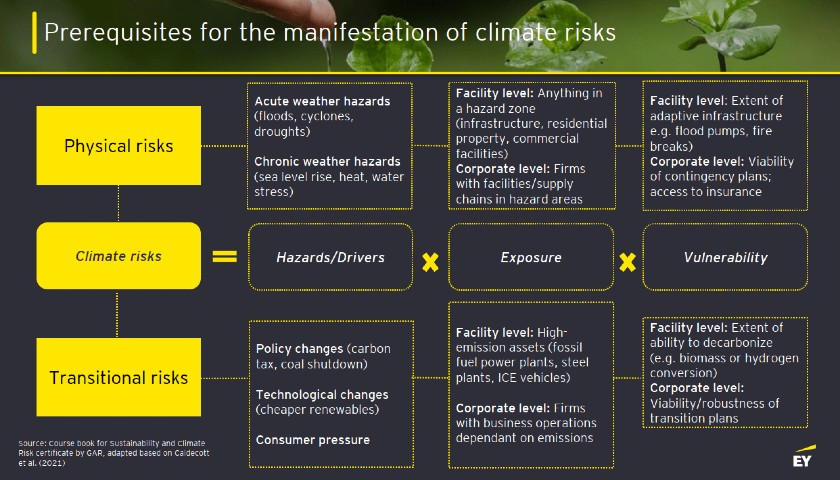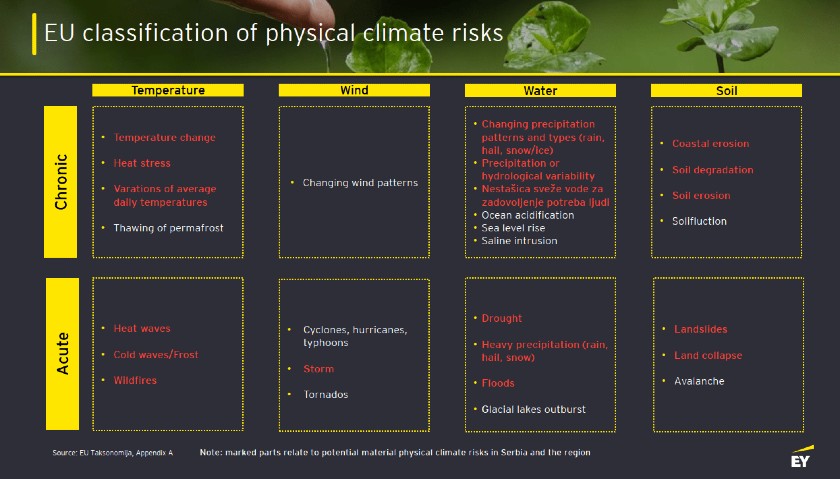
Photo: iStock
Authors: Aleksandra Tanasković, Jovana Ljujić and Danko Kalkan (EY ESG team)
Of all the ESG (environmental, social, and corporate governance) risks, those caused by accelerating climate change are probably the most complex. Climate risks are manifested through various phenomena and are often not immediately obvious. However, since these risks could soon start significantly affecting business decisions and the existing business models, it is important for companies to get acquainted with the categories of climate risks and the ways they materialize, as well as with the term “stranded assets”.
Over the past 40 years, extreme weather events caused by climate change have resulted in nearly EUR 500 billion worth of damage in the 27 EU member states, accounting for 80% of the total damage attributable to natural disaster risks. In Serbia, the damage from climate change since the year 2000 has been estimated at almost EUR 8 billion. Additionally, global trends show a constant increase in average annual losses caused by natural disasters.
The latest developments certainly do not herald the end of the problem. The summer of 2022 was one of the three hottest summers in Europe’s history. Britain was hit by the highest temperatures on record, exceeding 40°C, and people were advised not to go out for the first time ever. Wildfires engulfed areas in France, Portugal, Spain, and Greece, forcing thousands of people to leave their homes and claiming several lives.
In addition, extreme climate conditions caused problems in transportation and supply chains for some of the key products, further exacerbating the crisis caused by the pandemic and the new geopolitical reality. Due to drought, the water level in Europe’s most important waterway, the Rhine River, fell to an all-time low, with some parts of the river’s course becoming unnavigable even for empty vessels.
This is only a part of the story about how climate-related risks materialize and affect the economy and society.
Types of climate risks
Climate risks are divided into two broad categories: physical risks and transition risks. Physical risks are those resulting from physical impacts of climate change, while transition risks are those resulting from economic transformation or any change that requires the drastic reduction or elimination of greenhouse gases in line with the Paris climate agreement.
Physical risks are further divided into acute and chronic risks, while transition risks are split into four types: policy and regulatory risks, technological risks, reputational risks and risks resulting from client/consumer pressure, and market risks.

For physical and transition climate risks to materialize, certain preconditions need to be met. This means that hazard alone is not enough, and that two additional elements are required – exposure to risk and vulnerability.

Stranded assets
“Stranded assets” is an important term in the context of climate risks. It refers to assets that have suffered from unanticipated or premature write-downs, devaluation, or conversion to liabilities. The concept of stranded assets is most commonly associated with high transition climate risks, where it refers mainly to the energy and industrial sectors with carbon-intensive processes.
Specifically, due to the necessary transition towards cleaner energy sources, many countries are shutting down fossil-fuel thermal power plants even though the equipment and fossil fuel reserves have not been fully exhausted.
On the other hand, the concept also refers to physical climate risks, where risk concentration depends on location (e.g. rising sea levels and increased potential for flooding in coastal areas can jeopardize physical assets, causing their premature write-downs).
Finally, the term stranded assets can be associated with other environmental risks as well. These include the destruction of natural habitats and biodiversity loss, which can cause ecosystem collapse (e.g. the disappearance of bees and reduced pollination could lead to lower yields of certain key plants and production inputs). Also, more stringent environmental regulations could lead to shutdowns of certain facilities due to excessive pollution.
What climate risks should be watched out for in Serbia and the region?
The EU taxonomy of sustainable activities defines potential physical climate risks that companies should watch out for in the near future. The chart below shows all potential hazards, highlighting those risks which companies in Serbia and the region should pay particular attention to over the coming period.

Finally, when it comes to transition climate risks, the first to hit Serbia and the region will most likely be policy and regulatory risks (e.g. the introduction of a CO2 tax, which is expected as early as 2023), as well as technological risks, resulting mainly from falling prices of renewable energy technologies (solar, wind, etc.).
All in all, climate risks should be seen as strategic risks, and they should feature prominently in analyses of end-of-century scenarios when developing risk management strategies.


















Be the first one to comment on this article.